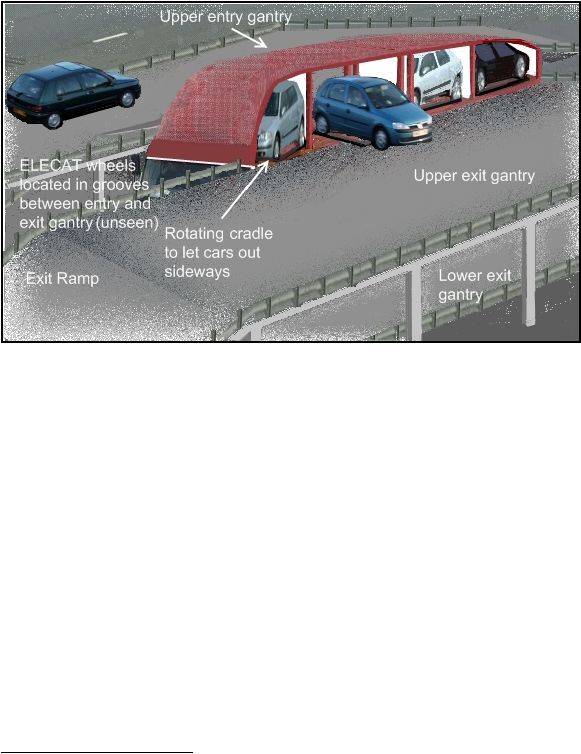
transported car is willing and qualified to drive the ELECAT, they could be dropped off near to the ELECAT
cab before the car is driven onto the ELECAT trailer so no time is lost for the remaining passengers. Further
development of an integrated system could lead to a ‘drive by wire’ system where one of the drivers in the
forward-loaded cars drives the ELECAT directly using their own car controls, saving further time and allocating
an extra space for a car.
The ELECAT should be designed to accommodate a wide range of car designs, carry a useful number of
vehicles and yet remain aerodynamic enough for high-speed use. This could be made far easier by slightly
extending the maximum permitted length of ELECATs allowed on highways, and limiting the length and height
of cars. This latter restriction would simultaneously discourage the use of oversize vehicles.
The transfer stations would be built within or near to present service stations; alternatively, highway junctions
could be adapted for this purpose. In each case, the stations should be strategically spaced so the BEVs would
be able to complete a long journey without the need for stationary re-charging.
Figure 17 ELECAT Transfer Station
The cars rest on guideways in the ELECAT. These guideways can be rotated to point sideways so the cars (the
drivers remain in the cars throughout the journey) can be driven on and off without interfering with the other
cars. In this example the aerodynamic side fabric isolating the compartments is automatically retracted prior to
transfer
The ELECAT’s would not necessarily stop at each transfer station along the route since this would reduce the
average speed of the journey. It is envisaged that a more flexible system could be used were ELECAT’s stop
only at the stations the specific passengers actually require. To do this efficiently it would be beneficial to use
information from a COAST type central computer which would be both monitoring current journeys and
anticipating others. This would ensure high utilisation on the transporter
45
and minimise overall transportation
time for the passengers.
Non-electric cars would initially be able to use the ELECAT. However, as a greater number of motorists choose
BEVs, the ELECAT could prioritise spaces for them. Major transfer stations would require several transfer bays
for ELECAT’s since these may be loading simultaneously and travelling over different routes and transfer
stations.
As with COAST, the mass use of ELECAT’s could justify separate lanes for these vehicles which could be
shared with buses and coaches as well as electric cars operating in the COAST mode. Alternately, the ELECAT
concept could be used in conjunction with a road charging system, where the cost of each car on the ELECAT
would be substantially less than if driven on the road due to the reduced road space taken (see section 4.5.4).
Since the ELECAT’s would still need access to the transfer stations, which may otherwise be blocked with
45 A high number of cars carried in relation to the car carrying capacity of the transporter

